
The Battle of Leipzig, also known as the Battle of the Nations, was fought from 16 to 19 October 1813 at Leipzig, Saxony. The Coalition armies of Austria, Prussia, Sweden, and Russia, led by Tsar Alexander I and Karl von Schwarzenberg, decisively defeated the Grande Armée of French Emperor Napoleon Bonaparte. Napoleon's army also contained Polish and Italian troops, as well as Germans from the Confederation of the Rhine. The battle was the culmination of the German Campaign of 1813 and involved 560,000 soldiers, 2,200 artillery pieces, the expenditure of 400,000 rounds of artillery ammunition, and 133,000 casualties, making it the largest battle of the Napoleonic Wars, and the largest battle in Europe prior to World War I.

The Battle of Brienne saw an Imperial French army led by Emperor Napoleon attack Prussian and Russian forces commanded by Prussian Field Marshal Gebhard Leberecht von Blücher. After heavy fighting that went on into the night, the French seized a château, nearly capturing Blücher. However, the French were unable to dislodge the Russians from the town of Brienne-le-Château. Napoleon himself, making his first appearance on a battlefield in 1814, was also nearly captured. Very early the next morning, Blücher's troops quietly abandoned the town and retreated to the south, conceding the field to the French.
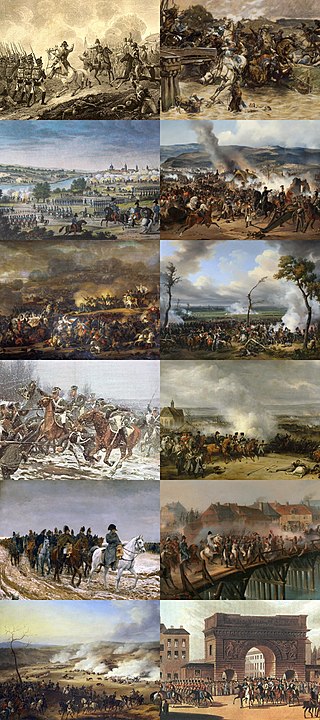
In the War of the Sixth Coalition, sometimes known in Germany as the Wars of Liberation, a coalition of Austria, Prussia, Russia, Spain, the United Kingdom, Portugal, Sweden, Sardinia, and a number of German States defeated France and drove Napoleon into exile on Elba. After the disastrous French invasion of Russia of 1812 in which they had been forced to support France, Prussia and Austria joined Russia, the United Kingdom, Sweden, and Portugal, and the rebels in Spain who were already at war with France.
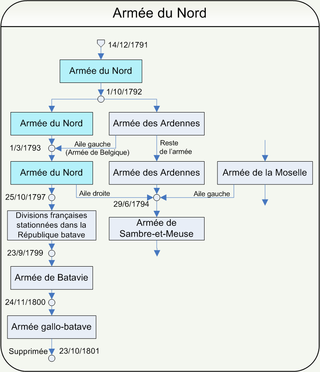
The Army of the North or Armée du Nord is a name given to several historical units of the French Army. The first was one of the French Revolutionary Armies that fought with distinction against the First Coalition from 1792 to 1795. Others existed during the Peninsular War, the Hundred Days and the Franco-Prussian War.
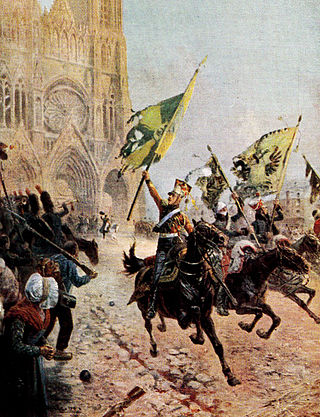
The Battle of Reims was fought at Reims, France between an Imperial French army commanded by Emperor Napoleon and a combined Russian-Prussian corps led by General Emmanuel de Saint-Priest. On the first day, Saint-Priest's Russians and General Friedrich Wilhelm von Jagow's Prussians easily captured Reims from its French National Guard garrison, capturing or killing more than half of its defenders. On the second day, an overconfident Saint-Priest carelessly deployed his forces west of the city, not grasping that Napoleon was approaching with 20,000 troops. Too late, Saint-Priest realized who he was fighting and tried to organize a retreat. In the battle that followed, the French army struck with crushing force and the Allies were routed with serious losses. During the fighting, Saint-Priest was struck by a howitzer shell and died two weeks later.

The Battle of Laon was the victory of Blücher's Prussian army over Napoleon's French army near Laon. During the Battle of Craonne on 7 March, Blücher's army was forced to retreat into Laon after a failed attempt to halt Napoleon's east flank. Along the way to Laon, reinforcements from Russian forces under Ferdinand von Wintzingerode and a Prussian corps led by Friedrich Wilhelm Freiherr von Bülow joined the defensive. Blücher opted to face Napoleon at Laon because it was the site of a strategically important road junction, and because of its highly defensible position.

The Principality of Erfurt was a small state in modern Thuringia, Germany, that existed from 1807 to 1814, comprising the modern city of Erfurt and the surrounding land. It was subordinate directly to Napoleon, the Emperor of the French, rather than being a part of the Confederation of the Rhine. After nearly 3 months of siege, the city fell to Prussian, Austrian and Russian forces. Having mainly been Prussian territory before the Napoleonic Wars, most of the lands were restored to Prussia by the Congress of Vienna.
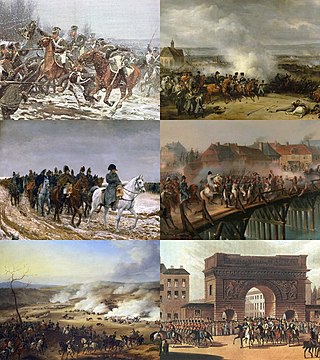
The 1814 campaign in north-east France was Napoleon's final campaign of the War of the Sixth Coalition. Following their victory at Leipzig in 1813, the Austrian, Prussian, Russian, and other German armies of the Sixth Coalition invaded France. Despite the disproportionate forces in favour of the Coalition, Napoleon managed to inflict several defeats, the Six Days' Campaign being the most well-known. However, the campaign ended in total defeat for Napoleon as the Coalition kept advancing towards Paris. Napoleon was out of position to defend the capital, which capitulated in late March 1814. When Napoleon proposed the army march on Paris, his Marshals decided to unanimously overrule Napoleon in order to save the city from further destruction. As a result, the victorious Coalition negotiated the Treaty of Paris, under which Napoleon was exiled to the island of Elba and the borders of France were returned to where they had been in 1792.

In the siege of Hamelin or siege of Hameln, First French Empire forces captured the fortress of Hamelin from its garrison composed of troops from the Kingdom of Prussia. The siege was begun by the VIII Corps under French Marshal Édouard Adolphe Casimir Joseph Mortier. The marshal initially left General of Division Jean-Baptiste Dumonceau in charge of operations. General of Division Anne Jean Marie René Savary soon arrived to conduct negotiations with the Prussian commander General Karl Ludwig von Lecoq, who was quickly persuaded to surrender. Technically, the operation from the War of the Fourth Coalition was a blockade because a formal siege never took place. Hamelin is located 36 kilometers southwest of Hanover.
Karl Ludwig von Lecoq or Karl Ludwig von Le Coq, born 23 September 1754 – died 14 February 1829, of French Huguenot ancestry, first joined the army of the Electorate of Saxony. He later transferred his loyalty to the Kingdom of Prussia and fought during the French Revolutionary Wars, earning a coveted award for bravery. While serving variously as a staff officer and diplomat, he became renowned as an expert cartographer. In 1806 he was entrusted with command of the forces in northwest Germany. Cut off from the main body of the Prussian army after the disaster at the Battle of Jena-Auerstedt, he concentrated his troops in the fortress of Hameln. After a brief siege, he surrendered his troops to an inferior force of enemies. For this, he was sentenced to life imprisonment. However, he was later pardoned and continued his map-making until he went blind.

Pierre François Joseph Durutte joined the French army at the beginning of the French Revolutionary Wars. Rapidly promoted for feats of bravery under fire at Jemappes in 1792 and Hondschoote in 1793, he found himself appointed to serve as a staff officer. He distinguished himself during the Anglo-Russian invasion of Holland in 1799 and received promotion to general officer. During the successful 1800 campaign he fought in Jean Victor Marie Moreau's army. Promoted again in 1803, his career then stalled because of his association with the banished Moreau and his unwillingness to see Napoleon Bonaparte as emperor.
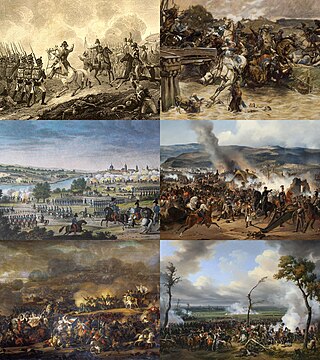
The German campaign was fought in 1813. Members of the Sixth Coalition, including the German states of Austria and Prussia, plus Russia and Sweden, fought a series of battles in Germany against the French Emperor Napoleon, his marshals, and the armies of the Confederation of the Rhine – an alliance of most of the other German states –, which ended the domination of the First French Empire.
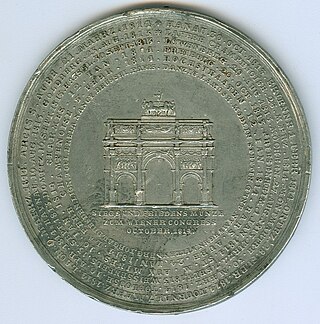
The Battle of Hoogstraten was fought on 11 January 1814 between a French army, led by François Roguet, and a Russo-Prussian-British army, led by Friedrich Wilhelm Freiherr von Bülow. The battle, which ended in a Prussian victory, consisted of a series of engagements situated between Essen and Turnhout. The battle was named after Hoogstraten, the main town of the Kempen region.

After the defeat of Napoleon at the Battle of Waterloo and the advance on Paris by the Coalition armies during the months of June and July 1815, although they besieged and took some towns and fortresses as they advanced, they bypassed many of them and detached forces to observe and reduce them. The last of the French fortresses did not capitulate until September of that year.

Charles Louis Dieudonné Grandjean became a French division commander and saw extensive service during the Napoleonic Wars. In 1792 he gave up his legal career to enlist in the infantry and served in the Army of the Rhine. In March 1799 he earned promotion to general of brigade by distinguished actions at Verona. That year he led an Army of Italy brigade at Magnano, the Trebbia, Novi and Genola. In 1800 he fought at Stockach and Hohenlinden.

Étienne Pierre Sylvestre Ricard was a prominent French division commander during the 1814 Campaign in Northeast France. In 1791 he joined an infantry regiment and spent several years in Corsica. Transferred to the Army of Italy in 1799, he became an aide-de-camp to Louis-Gabriel Suchet. He fought at Pozzolo in 1800. He became aide-de-camp to Marshal Nicolas Soult in 1805 and was at Austerlitz and Jena where his actions earned a promotion to general of brigade. From 1808 he functioned as Soult's chief of staff during the Peninsular War, serving at Corunna, Braga, First and Second Porto. During this time he sent a letter to Soult's generals asking them if the marshal should assume royal powers in Northern Portugal. When he found out, Napoleon was furious and he sidelined Ricard for two years.
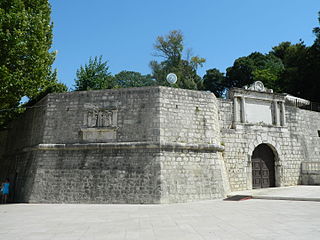
The siege of Zara or siege of Zadar, also known as the blockade of Zara, was a military event that took place between 22 November and 5 December 1813, during the Adriatic Campaign of the Napoleonic Wars. During the siege, an Anglo-Austrian force under command of George Cadogan in HMS Havannah blockaded and bombarded Zara which was then held by a French garrison. Within two weeks, the garrison surrendered to the attackers.

The Battle of Arnhem saw Friedrich Wilhelm Freiherr von Bülow's Prussian corps fight an Imperial French division under Henri François Marie Charpentier at Arnhem. Attacking under the cover of fog, the Prussians broke into the city at several points and forced the French to retreat to Nijmegen after hard fighting in this War of the Sixth Coalition clash. Arnhem is a city in the Netherlands located on the Rhine River 100 kilometres (62 mi) southeast of Amsterdam.
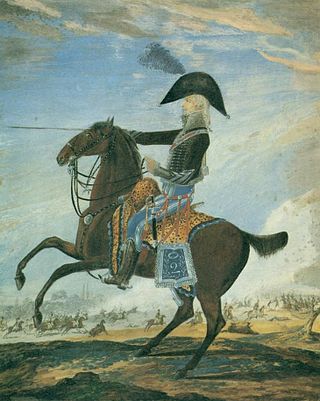
Charles Étienne de Ghigny commanded a Kingdom of the Netherlands light cavalry brigade at the Battle of Waterloo. He joined a French light cavalry regiment in 1792 and served in the same regiment for 22 years, becoming its lieutenant colonel in 1806. He fought in the Peninsular War in 1810–1811 and in the latter year became colonel of the regiment. He fought in the 1812 French invasion of Russia, the 1813 German Campaign and the 1814 French Campaign. In 1814 he led a cavalry regiment at Fère-Champenoise and Paris. He changed his allegiance to the Netherlands in 1815 and was appointed major general. He was promoted to lieutenant general in 1826. He switched allegiance to the Kingdom of Belgium in 1831 and received the Order of Leopold in 1837.

The siege of Antwerp took place from 14 January 1814 to 4 May 1814, during the War of the Sixth Coalition. Led by Governor Lazare Carnot, Antwerp, then a French city, resisted an Allied siege until Napoleon's abdication and the signing of an armistice.




















